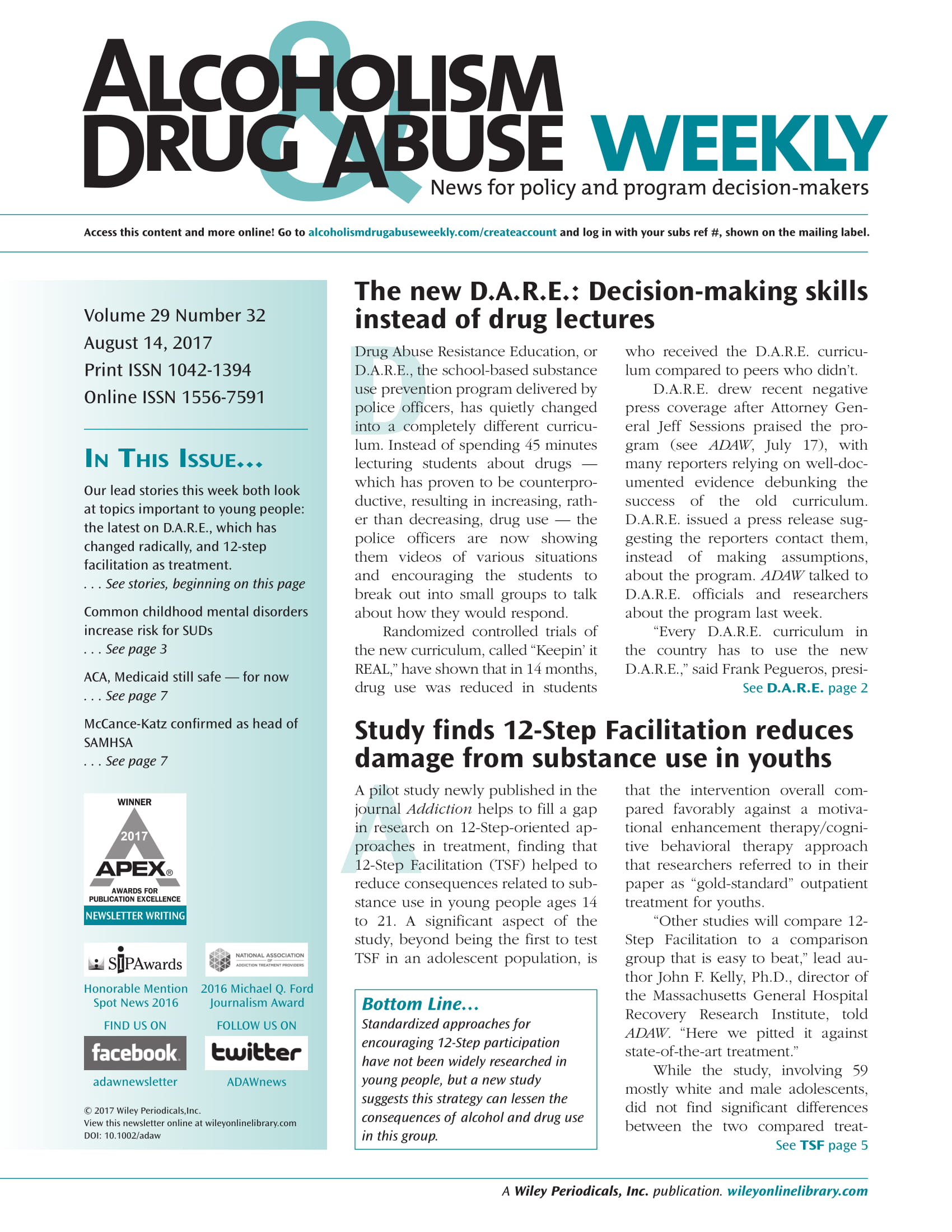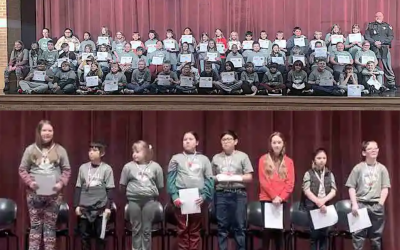Drug Abuse Resistance Education, or D.A.R.E., the school-based substance use prevention program delivered by police officers, has quietly changed into a completely different curriculum. Instead of spending 45 minutes lecturing students about drugs — which has proven to be counterproductive, resulting in increasing, rather than decreasing, drug use — the police officers are now showing them videos of various situations and encouraging the students to break out into small groups to talk about how they would respond.
Randomized controlled trials of the new curriculum, called “keepin’ it REAL,” have shown that in 14 months, drug use was reduced in students who received the D.A.R.E. curriculum compared to peers who didn’t.
D.A.R.E. drew recent negative press coverage after Attorney General Jeff Sessions praised the program (see ADAW, July 17), with many reporters relying on well-documented evidence debunking the success of the old curriculum. D.A.R.E. issued a press release suggesting the reporters contact them, instead of making assumptions, about the program. ADAW talked to D.A.R.E. officials and researchers about the program last week.
“Every D.A.R.E. curriculum in the country has to use the new D.A.R.E.,” said Frank Pegueros, president and CEO of D.A.R.E. America. School districts who participate agree to deliver the curriculum provided by D.A.R.E. — that has always been the case, Pegueros told ADAW. The new middle school curriculum was implemented first, in 2010, and the elementary school curriculum was rolled out over the 2012–2013 period.
The History
D.A.R.E. officials started looking into the need to change the program in response to criticisms in the late 1980s and early 1990s “as a result of research showing that we did not have positive behavioral outcomes for elementary school,” Pegueros said. “We had a meeting of the critics, sponsored by the Department of Education, and everybody who had an interest came to the table.” The upshot of the meeting was that the Robert Wood Johnson Foundation would fund development, research and evaluation of a new curriculum, said Pegueros.
The curriculum was called “Take Charge of Your Life,” said Pegueros. “It was a massive undertaking. D.A.R.E. agreed to offer our body to science. We said we will deliver a world-class curriculum if you will give us one.”
The evaluation was indeed extensive — five metropolitan areas. “We were relieved, because we thought, ‘We’re finally going to get an elementary curriculum that can be evaluated.’ But it was not to happen. It’s virtually impossible to show positive outcomes with an elementary school program, because the use of illicit substances is so low,” said Pegueros. “But we were being criticized for not showing a positive outcome,” he said.
“We had positive outcomes for four years, but it diminished, and by the seventh year, there were no observable positive outcomes. Quite honestly, if you look at a lot of programs on the registry (NREPP [the National Registry of Evidence-based Programs and Practices]), four years of positive outcomes are still good. But the methodology wouldn’t allow for anything other than a seven-year goalpost.”
However, the Department of Education insisted that the prevention message start before the age of experimentation and use, said Pegueros. “They said, ‘Don’t give up. We will build you a middle and high school program instead, and evaluate that.’”
So the D.A.R.E. board of directors asked Pegueros to find an existing curriculum to adopt. “We found nine on the NREPP that could possibly meet our criteria,” said Pegueros. But eight of those had a “fatal flaw,” he said — the training component, in which school districts sent their employees to training but those employees were not delivering the complete curriculum. Pegueros also said that the NREPP contractor at the time “questioned the use of police officers to deliver substance use prevention information.”
Only one program — keepin’ it REAL — had no “fatal flaw,” said Pegueros.
The Researcher
Michael L. Hecht, Ph.D., formerly of Pennsylvania State University, conducted the original research on keepin’ it REAL, which was cited as part of the NREPP submission in December 2006, according to the Substance Abuse and Mental Health Services Administration (SAMHSA). The program profile listing shows another implementation of the same program in 2012, according to SAMHSA.
Hecht is now retired from Penn State but is president of a company he started called REAL Prevention, and now owns the license to keepin’ it REAL.
In general, evidence-based prevention curricula are not used, and if they are, they are not used very well, said Hecht. Teachers make adaptations, leave out certain chapters and so on, he said. “One of the things we’ve done in keepin’ it REAL is to accommodate the need to adjust to the audience base,” he said. “Kids fill in their own narratives around the stories.”
Relationship with Police
Even in the old D.A.R.E., which could not show reduced drug use, there was proof that the children had more trust in the police after participating. This is a benefit under the new program as well, said Hecht. “I think a relationship with a person of authority, the view of the police through the kids’ eyes that the family gets — this changes the way kids and families see police,” Hecht said. “In essence, this is community policing,” he said. And it works both ways. “I’ve heard many many stories about how police say they see the community differently” after doing D.A.R.E. presentations in the classroom,” he said.
Recent events — police shootings and other reports, such as children being arrested and handcuffed in schools — may have done damage to that trust, Hecht admitted. “There are clearly policing problems in our communities,” he said. “I would guess that having D.A.R.E. affects things like that. We do know that our study showed D.A.R.E. has a positive effect on attitudes toward police. More students believe police would help them if they need it than in the control groups.”
Focusing exclusively on the drugs, as the old D.A.R.E. did, is “almost as if you’re giving the high-risk kids a menu,” said Hecht.
But there are still not good answers to questions about whether developing resilience in children can prevent substance use, or prevent other problems, such as mental illness, said Hecht. “The federal government hasn’t gone in that direction” in terms of funding, he said. “Research follows the funding.”
Multicultural
There have been three randomized controlled trials of the new D.A.R.E., said Hecht. The multicultural curriculum had the broadest range of effects, he said. This way, no particular group of children thought they were singled out as guilty of drug use.
“If you create a curriculum around a group of kids, it communicates to those kids that they’re the problem, that they’re the drug users,” said Hecht. For example, if only white children are used in videos, this makes white children feel targeted. The same with Latinos, he said. Diversity is key.
In addition to the curriculum being changed, the delivery method is new, based on facilitation instead of a didactic lecture, said Pegueros. “The D.A.R.E. officer only talks for eight minutes of the 45-minute presentation,” he said. “The rest of the time is students working in small learning groups.”
There are 22 state-supported training centers, where D.A.R.E. America provides the 80-hour instruction course. About 10,000 to 12,000 officers have taken the two-week course, said Pegueros.
About 50 to 60 percent of all school districts now participate in D.A.R.E., said Pegueros.
REAL stands for the four ways kids can refuse drug offers: Refuse, Explain, Avoid and Leave.
What hasn’t changed: police officers still deliver the curriculum.
For studies on D.A.R.E., see:
Hecht ML, Graham JW, Elek E. The drug resistance strategies intervention: Program effects on substance use. Health Commun 2006; 20(3):267–276.
Kulis S, Nieri T, Yabiku S, et al. Promoting reduced and discontinued substance use among adolescent substance users: Effectiveness of a universal prevention program. Prev Sci 2007 Mar; 8(1):35–49. Epub 2006 Nov 10.
Marsiglia FF, Kulis S, Yabiku ST, et al. When to intervene: Elementary school, middle school or both? Effects of Keepin’ it REAL on substance use trajectories of Mexican heritage youth. Prev Sci 2011 Mar; 12(1):48–62. doi: 10.1007/s11121-010-0189-y.
Pettigrew J, Graham JW, Milller-Day M, et al. Adherence and delivery: Implementation quality and program outcomes for the seventh grade Keepin’ it REAL program. Prev Sci 2015 Jan; 16(1):90–99. doi: 10.1007/s11121-014-0459-1.
From the August 14, 2017 issue of Alcoholism & Drug Abuse Weekly.
4,500 Students Graduate from D.A.R.E. Mexico in Tijuana
Tijuana, Baja California, February 23, 2023 – More than 4,500 preschool, Elementary, and Middle school students from 43 schools in Tijuana, Mexico, graduated from the D.A.R.E. program. Students completed their preventive education program against drug use courses…
D.A.R.E. Graduation at Paulding Elementary School
D.A.R.E. program in Paulding County is going strong with a new Deputy at the helm, Deputy Rich Phelan. In January he completed the 12 week coursework with the Antwerp Elementary 5th graders. This past week, he graduated the 5th grade class of Paulding Elementary….
Xylazine….Worse than Fentanyl
Xylazine….Worse than Fentanyl Increasingly around the country, the animal tranquilizer xylazine — known by street names like “tranq,” “tranq dope” and “zombie drug” — is being used as an additive by drug dealers of illicit fentanyl laced opioids, making its impact...
Fentanyl FAQ and Talking Points
Fentanyl Have a conversation with students or your children. Simply telling teens to not do drugs is not the most effective way to discuss fentanyl and other opioid drug risks. The teens that are the most at risk may just tune this warning out if they feel like...
Lafayette County’s D.A.R.E. Program Graduates 225 Students
Lafayette’s D.A.R.E. program graduated 225 students recently. The D.A.R.E. program taught by Lafayette County deputies is a 10-week course that focuses on how students can make responsible decisions when it comes to drugs, alcohol, tobacco, bullying and peer pressure.
Support D.A.R.E. and enter for a chance to win!
D.A.R.E. curricula provide students the knowledge and skills to make good decisions for safe and healthy living. D.A.R.E.'s keepin' it REAL elementary and middle-school curricula are based on Socio-Emotional Learning Theory which identifies basic skills and processes...
The Power of Prevention | D.A.R.E. Video
D.A.R.E. is Different | Richard Clayton PhD
A Different Kind of D.A.R.E.
The principle is still the same: Friendly officers from the Moorhead Police Department come to fifth grade classrooms every day to prepare kids to make good decisions. But if you attended elementary school in the 1980s and 1990s, when the nationwide program was in its...
Copyright © 2022 D.A.R.E. America. All Rights Reserved.
Copyright © 2022 D.A.R.E. America.
All Rights Reserved.












